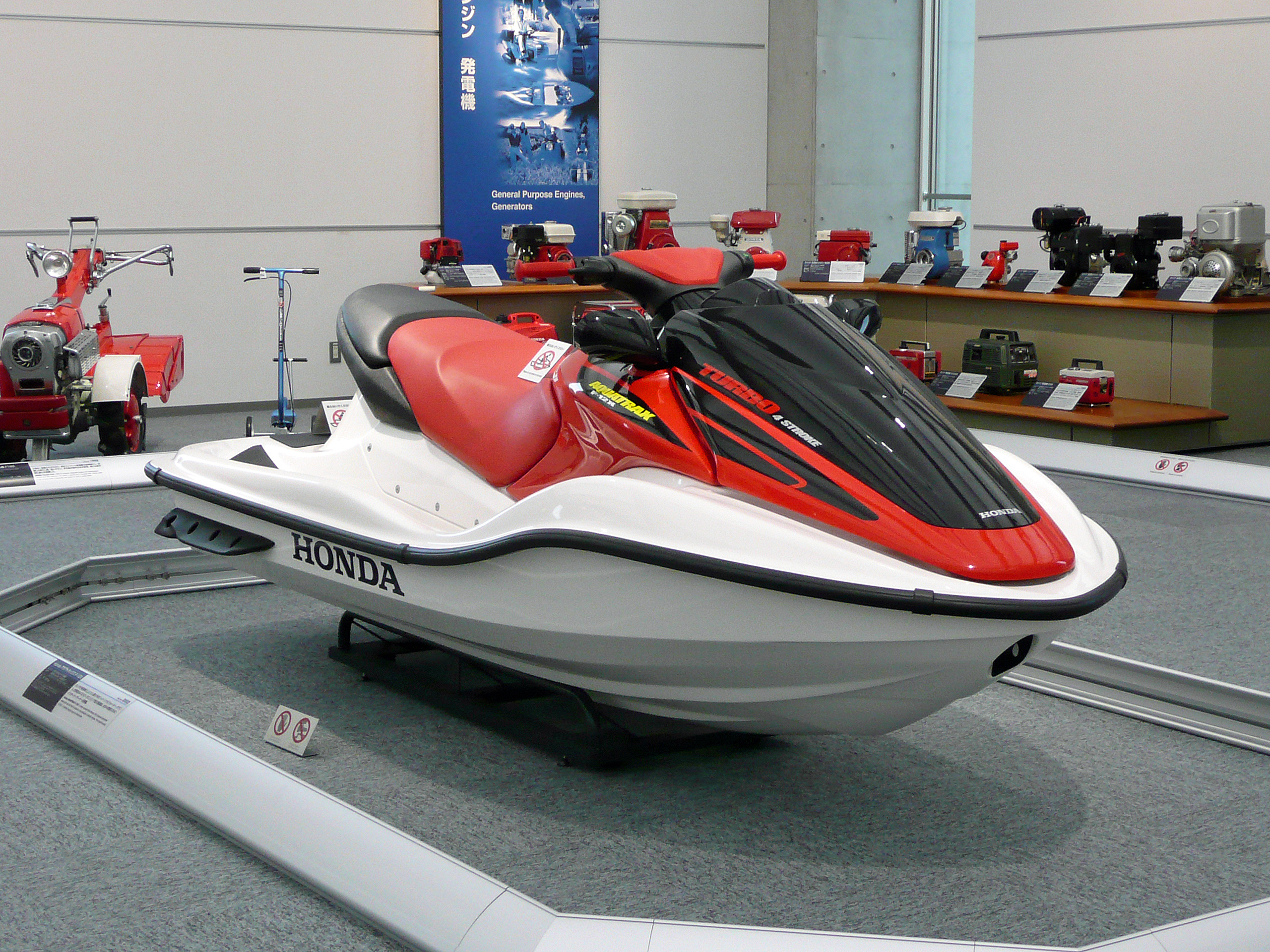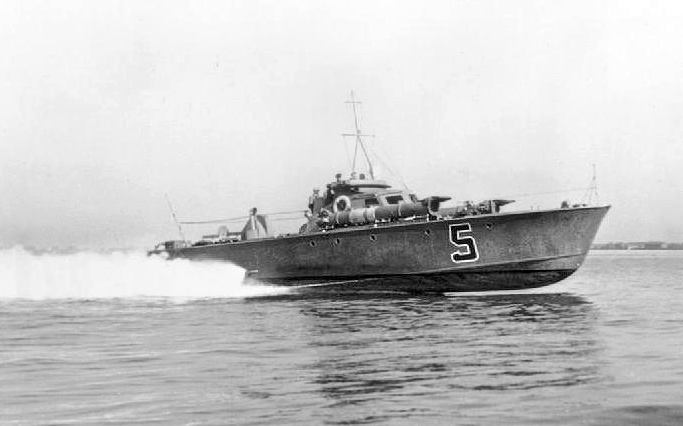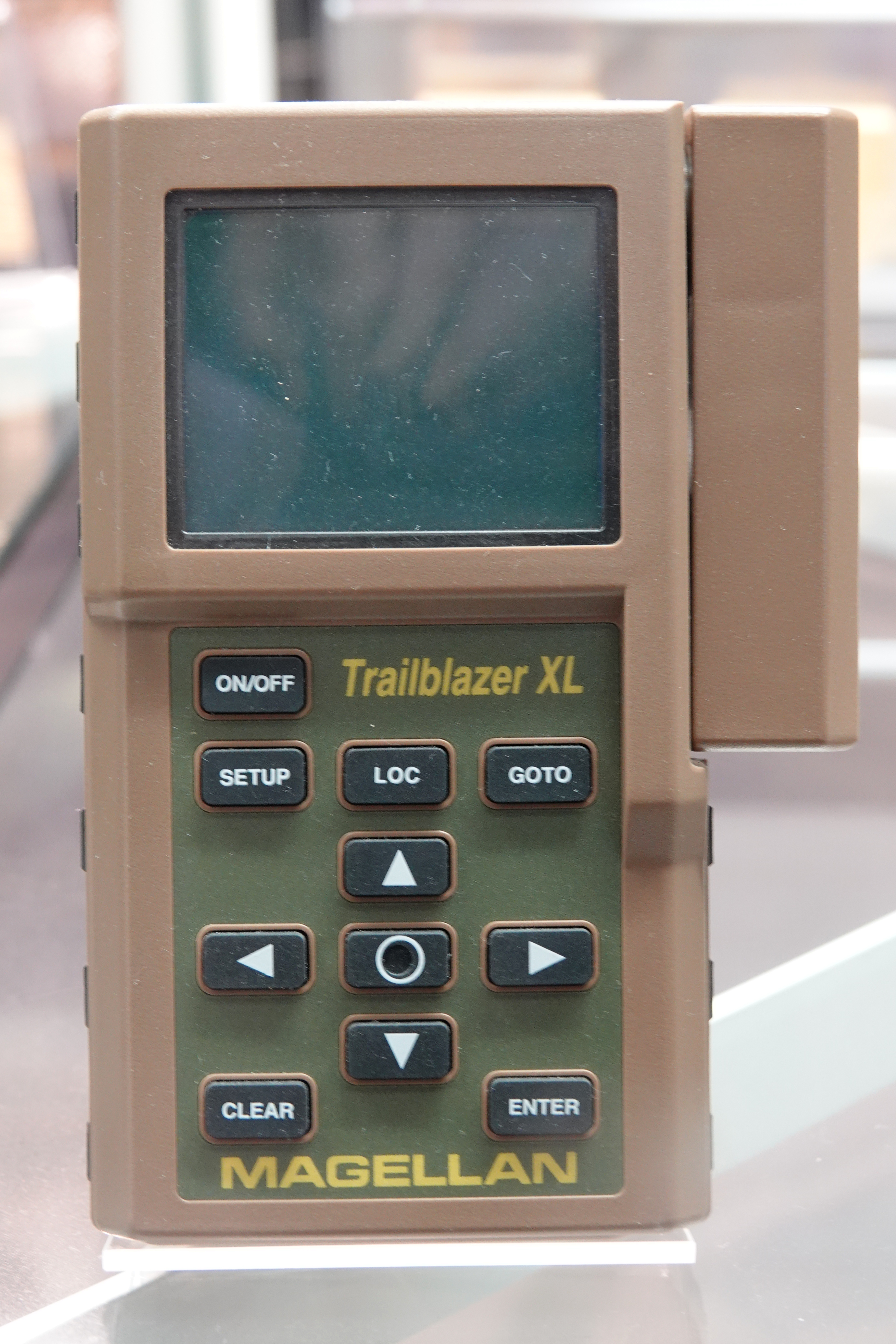|
Yamaha WaveBlaster
The WaveBlaster is a personal water craft (PWC) made by Yamaha Motor Corporation. Part of their WaveRunner line of watercraft, the Yamaha WaveBlaster 700 (Marine Jet 700TZ) made its debut in 1993. Although technically a runabout style PWC the blaster is more closely related to the SuperJet. Yamaha's design philosophy for the Blaster was simplicity over comfort. Just handle bars with a trigger throttle and a motorcycle style seat made this a performance craft, that let riders enjoy sharply banked turns, tail stands and other acrobatic maneuvers. The performance character and lean in style turning is primarily due to the soft chines but are further enhanced by concave sections near the bow and Strakes along the hull. The claimed top speed was 44-45 mph. With its powerful engine, semi flat-bottomed hull, and chrome-alloy piston rings, this is a model that still has many devoted fans today. The drawbacks to the design is its high center of gravity making it difficult to ride at id ... [...More Info...] [...Related Items...] OR: [Wikipedia] [Google] [Baidu] |
Yamaha Motor
is a Japanese multinational manufacturer of motorcycles, marine products such as boats and outboard motors, and other motorized products. The company was established in 1955 upon separation from Yamaha Corporation (however, Yamaha Corporation is still the largest private company shareholder with 9.92%, as of 2019), and is headquartered in Iwata, Shizuoka, Japan. The company conducts development, production and marketing operations through 109 consolidated subsidiaries as of 2012. Led by Genichi Kawakami, the company's founder and first president, Yamaha Motor spun off from musical instrument manufacturer Yamaha Corporation in 1955 and began production of its first product, the YA-1 125cc motorcycle. It was quickly successful and won the 3rd Mount Fuji Ascent Race in its class. The company's products include motorcycles, scooters, motorized bicycles, boats, sail boats, personal water craft, swimming pools, utility boats, fishing boats, outboard motors, 4-wheel ATVs, recreat ... [...More Info...] [...Related Items...] OR: [Wikipedia] [Google] [Baidu] |
Personal Water Craft
A personal watercraft (PWC), also called water scooter or jet ski, is a recreational watercraft that a rider sits or stands on, not within, as in a boat. PWCs have two style categories, first and most popular being a runabout or "sit down" where the rider uses the watercraft mainly sitting down, and the watercraft typically holds two or more people. The second style is a "stand-up", where the rider uses the watercraft standing up. The stand-up styles are built for one rider and are used more for doing tricks, racing, and use in competitions. Both styles have an inboard engine driving a pump-jet that has a screw-shaped impeller to create thrust for propulsion and steering. Most are designed for two or three people, though four-passenger models exist. Many of today's models are built for more extended use and have the fuel capacity to make long cruises, in some cases even beyond 100 miles (161 km). Personal watercraft are often referred by the trademarked brand names of p ... [...More Info...] [...Related Items...] OR: [Wikipedia] [Google] [Baidu] |
Yamaha Motor Corporation
is a Japanese multinational manufacturer of motorcycles, marine products such as boats and outboard motors, and other motorized products. The company was established in 1955 upon separation from Yamaha Corporation (however, Yamaha Corporation is still the largest private company shareholder with 9.92%, as of 2019), and is headquartered in Iwata, Shizuoka, Japan. The company conducts development, production and marketing operations through 109 consolidated subsidiaries as of 2012. Led by Genichi Kawakami, the company's founder and first president, Yamaha Motor spun off from musical instrument manufacturer Yamaha Corporation in 1955 and began production of its first product, the YA-1 125cc motorcycle. It was quickly successful and won the 3rd Mount Fuji Ascent Race in its class. The company's products include motorcycles, scooters, motorized bicycles, boats, sail boats, personal water craft, swimming pools, utility boats, fishing boats, outboard motors, 4-wheel ATVs, recreat ... [...More Info...] [...Related Items...] OR: [Wikipedia] [Google] [Baidu] |
Yamaha WaveRunner
WaveRunner is a trademarked name and type of personal water craft (PWC) produced by the Yamaha Motor Company. Unique to the WaveRunner among PWCs is the spout of water that shoots into the air from the rear of the vehicle, a visual brand identifier that exists as a trademark of Yamaha. History The first personal watercraft was designed and built in the 1960s by an American motorcycle enthusiast banker, Clayton Jacobson II, and produced and marketed by Bombardier in a licensing agreement. In 1971 Jacobson transferred the license to Kawasaki, resulting in the Jet Ski. Other manufacturers began making similar vehicles in the 1980s, including Yamaha, which had been building watercraft since the '60s, and with whose water vehicle division Jacobson signed on a consultant in 1986. First produced that year, the WaveRunner (then called Marine Jet 500T) was the world's first saddle watercraft, a model which today dominates the market. In 1987, the handlebars mounted on an articulated ar ... [...More Info...] [...Related Items...] OR: [Wikipedia] [Google] [Baidu] |
Yamaha SuperJet
The SuperJet is a stand-up type personal watercraft (PWC) made by Yamaha Motor Corporation. Part of Yamaha's WaveRunner line of watercraft, it was introduced in 1990 and has become one of the most successful stand-up personal watercraft ever made. All SuperJets, including the engine, are hand-built in Japan. Credit for the design is given to Clayton Jacobson II. Prior to the introduction of the new Kawasaki SX-R 1500 four stroke on October 6, 2016, it has been the only stand-up sold by a major manufacturer since the Kawasaki SX-R 800 was discontinued in 2011. There are three engine generations spanning 1990-1993, 1994-1995, and 1996-2020, and three hull generations spanning 1990-1995, 1996-2007, and 2008-2020. 2019 marks the 30th year of production for the SuperJet. The current model SuperJet is powered by a 701cc inline two-cylinder, two-stroke engine. All generations have an upper and lower hull constructed from SMC (sheet molded compound). SMC is a compression moldable c ... [...More Info...] [...Related Items...] OR: [Wikipedia] [Google] [Baidu] |
Chine (boating)
A chine in boat design is a sharp change in angle in the Cross_section_(geometry), cross section of a hull (watercraft), hull. The chine typically arises from the use of sheet materials (such as sheet metal or marine ply) as the mode of construction. Rationale of chines Using sheet materials in boat construction is cheap and simple, but whereas these sheet materials are flexible longitudinally, they tend to be rigid vertically. Examples of steel vessels with hard chines include narrowboats and widebeams; examples of plywood vessels with hard chines include sailing dinghies such as the single-chined Graduate (dinghy), Graduate and the double-chined Enterprise (dinghy), Enterprise. Although a hull made from sheet materials might be unattractively "slab-sided", most chined hulls are designed to be pleasing to the eye and hydrodynamics, hydrodynamically efficient. Hulls without chines (such as Clinker (boat building), clinker-built or Carvel (boat building), carvel-built vessels) u ... [...More Info...] [...Related Items...] OR: [Wikipedia] [Google] [Baidu] |
Strake
On a vessel's hull, a strake is a longitudinal course of planking or plating which runs from the boat's stempost (at the bows) to the sternpost or transom (at the rear). The garboard strakes are the two immediately adjacent to the keel on each side. The word derives from traditional wooden boat building methods, used in both carvel and clinker construction. In a metal ship, a strake is a course of plating. Construction In small boats strakes may be single continuous pieces of wood. In larger wooden vessels strakes typically comprise several planks which are either scarfed, or butt-jointed and reinforced with a butt block. Where the transverse sections of the vessel's shape are fuller, the strakes are wider; they taper toward the ends. In a riveted steel ship, the strakes were usually lapped and joggled (one strake given projections to match indentions in the one adjoining), but where a smoother finish was sought they might be riveted on a butt strap, though this w ... [...More Info...] [...Related Items...] OR: [Wikipedia] [Google] [Baidu] |
Tachometer
A tachometer (revolution-counter, tach, rev-counter, RPM gauge) is an instrument measuring the rotation speed of a shaft or disk, as in a motor or other machine. The device usually displays the revolutions per minute (RPM) on a calibrated analogue dial, but digital displays are increasingly common. The word comes from Greek ''τάχος'' (''táchos'' "speed") and ''μέτρον'' (''métron'' "measure"). Essentially the words tachometer and speedometer have identical meaning: a device that measures speed. It is by arbitrary convention that in the automotive world one is used for engine revolutions and the other for vehicle speed. In formal engineering nomenclature, more precise terms are used to distinguish the two. History The first tachometer was described by an Donkin in a paper to the Royal Society of Arts in 1810 for which he was awarded the Gold medal of the society. This consisted of a bowl of mercury constructed in such a way that centrifugal force caused the level ... [...More Info...] [...Related Items...] OR: [Wikipedia] [Google] [Baidu] |
Speedometer
A speedometer or speed meter is a gauge that measures and displays the instantaneous speed of a vehicle. Now universally fitted to motor vehicles, they started to be available as options in the early 20th century, and as standard equipment from about 1910 onwards. Other vehicles may use devices analogous to the speedometer with different means of sensing speed, eg. boats use a pit log, while aircraft use an airspeed indicator. Charles Babbage is credited with creating an early type of a speedometer, which was usually fitted to locomotives. The electric speedometer was invented by the Croatian Josip Belušić in 1888 and was originally called a velocimeter. Operation The speedometer was originally patented by Josip Belušić (Giuseppe Bellussich) in 1888. He presented his invention at the 1889 Exposition Universelle in Paris. His invention had a pointer and a magnet, using electricity to work. German inventor Otto Schultze patented his version (which, like Belušić's, ra ... [...More Info...] [...Related Items...] OR: [Wikipedia] [Google] [Baidu] |
GPS Navigation Device
A satellite navigation device (satnav device) is a user equipment that uses one or more of several global navigation satellite systems (GNSS) to calculate the device's geographical position and provide navigational advice. Depending on the software used, the satnav device may display the position on a map, as geographic coordinates, or may offer routing directions. As of September 2020, there were four operational GNSS systems, the original United States' Global Positioning System (GPS), the European Union's Galileo, Russia's GLONASS, and China's BeiDou Navigation Satellite System. The Indian Regional Navigation Satellite System (IRNSS) will follow and Japan's Quasi-Zenith Satellite System (QZSS) scheduled for 2023 will augment the accuracy of a number of GNSS. A satellite navigation device can retrieve location and time information from one or more GNSS systems in all weather conditions, anywhere on or near the Earth's surface. Satnav reception requires an unobstructed ... [...More Info...] [...Related Items...] OR: [Wikipedia] [Google] [Baidu] |
Cup Holder
A cup holder is a device, such as a zarf, to hold a cup or other drinking vessel. It may be free standing to hold cups securely on a desk or other flat surface, or in a tree style to store sets of cups in kitchens. They may be built into automobiles or chairs, or fixed to the walls of airplanes, boats, buses and trains. Automobile cup holder The development of the drive-in restaurant was a step in the cup holder's development. Servers would attach a tray that hooked over the car's side window, which needed to be left up a little for it to attach to. This gave a temporary table to hold drinks and food while eating in the car. The drive-in restaurant and cinema encouraged the development of built-in tray tables; often, the inside of the glove compartment lid, when folded down, had indentations to hold cups, cans as well as pistachio shells and were found in cars as early as the 1957 Chevrolet Bel Air. These were sufficient to hold beverages when the car was stopped, but no ... [...More Info...] [...Related Items...] OR: [Wikipedia] [Google] [Baidu] |
Pump-jet
A pump-jet, hydrojet, or water jet is a marine system that produces a jet of water for propulsion. The mechanical arrangement may be a ducted propeller (axial-flow pump), a centrifugal pump, or a mixed flow pump which is a combination of both centrifugal and axial designs. The design also incorporates an intake to provide water to the pump and a nozzle to direct the flow of water out of the pump.http://www.hamiltonmarine.co.nz/includes/files_cms/file/JetTorque%2008.pdf Design A pump-jet works by having an intake (usually at the bottom of the hull) that allows water to pass underneath the vessel into the engines. Water enters the pump through this inlet. The pump can be of a centrifugal design for high speeds, or an axial flow pump for low to medium speeds. The water pressure inside the inlet is increased by the pump and forced backwards through a nozzle. With the use of a ''reversing bucket'', reverse thrust can also be achieved for faring backwards, quickly and withou ... [...More Info...] [...Related Items...] OR: [Wikipedia] [Google] [Baidu] |







